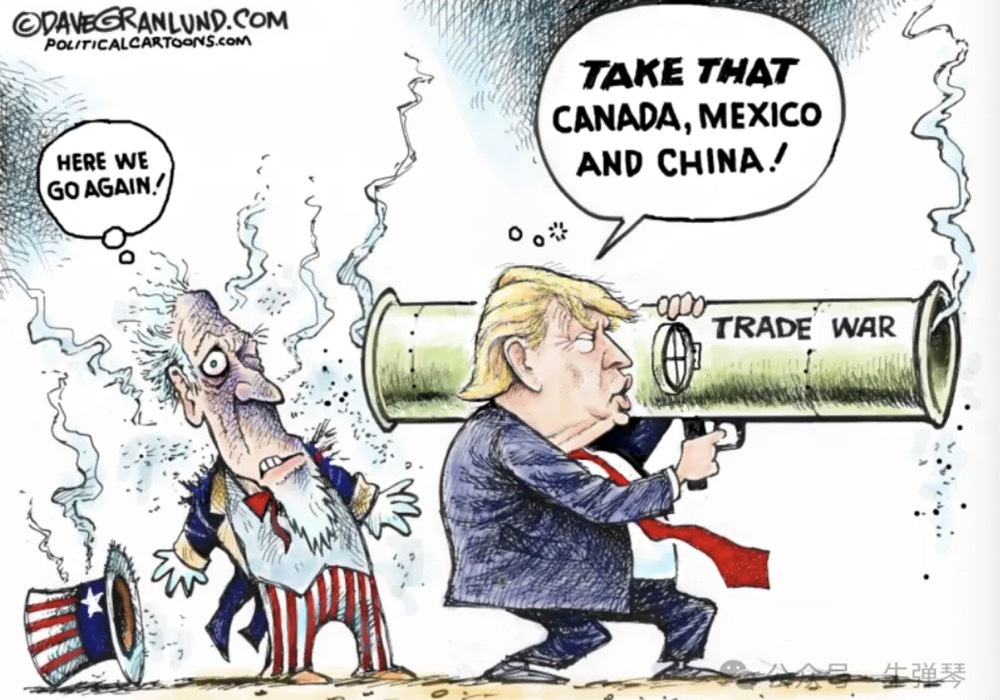The saying "somethings are destined to happen to you and will never escape you" perfectly describes the situation for Canada and Mexico, as they once again find themselves in serious trade trouble.
Just after a last-minute emergency phone call with Trump, where both countries pledged cooperation and made concessions, Trump temporarily suspended a planned 25% tariff hike for 30 days. However, in a sudden reversal, Trump has now announced a blanket 25% tariff on all imported steel and aluminum—leaving Canada and Mexico stunned.

Who Are the Biggest Losers?
Although Trump's tariffs target the world, the hardest-hit countries are Canada and Mexico.
According to trade data:
Canada is the largest steel exporter to the U.S., accounting for nearly 25% of total U.S. steel imports.
Mexico is the third-largest supplier, contributing around 12%.
Canada also supplies 79% of the U.S.'s imported raw aluminum, while Mexico supplies aluminum scrap and alloys.
Why isn't China affected?
Due to previous U.S. trade policies and discriminatory tariffs, China's highly competitive steel and aluminum products have already been largely excluded from the U.S. market.
Thus, while Trump momentarily spared Canada and Mexico, he has now delivered a harsh blow, leaving both countries in a state of frustration and disbelief.
Trump 2.0: Who Faces the Biggest Impact?
Many assumed China would bear the brunt of Trump's return to power. However, this isn't entirely accurate.
China will certainly face challenges, and Beijing must prepare for trade battles.
However, the biggest immediate impact will be felt within the United States and among Washington's closest allies.
Domestically, the U.S. is already in turmoil: Political divisions are deepening, with legal battles and public outrage intensifying.
Elon Musk's aggressive layoffs have sparked widespread backlash as job losses hit American workers hard.
Among U.S. allies, frustration is boiling over.
Trump's trade war strategy appears to follow a three-step escalation:
Targeting Canada, Mexico, and China (key trading partners).
Expanding tariffs to all steel and aluminum exporting nations, including Canada, Brazil, Mexico, South Korea, Vietnam, the UK, and Australia.
Introducing a new wave of "reciprocal tariffs" on all foreign imports, affecting the EU, UK, Australia, South Korea, and more.

Trump's Love for Tariffs: A Political and Economic Tactic
Trump has long been obsessed with tariffs, once calling them "the most beautiful word in the dictionary."
His tariff strategy serves multiple purposes:
- Political pressure: Tariffs are used as a negotiation tool, such as the first round of tariffs on Canada and Mexico, imposed under the pretext of stopping fentanyl and illegal immigration.
- Trade disputes: He justifies tariffs by accusing foreign governments of subsidizing their industries, discriminating against U.S. companies, or maintaining large trade surpluses with the U.S.
- Revenue generation: Some tariffs are simply a way to increase government income, essentially forcing American consumers to pay more for imports.
Despite warnings from economists that tariff costs ultimately fall on American consumers, Trump remains undeterred.
As one U.S. analyst said, "A few phone calls won't stop these tariffs. Structural tariffs are coming, and they are here to stay."
Global Reactions: Frustration and Retaliation
The world is growing increasingly anxious over Trump's aggressive trade policies.
The UK's steel industry has warned that U.S. tariffs could devastate British steel exports, as the U.S. is the UK's second-largest steel market after the EU.
The EU has clarified that it will retaliate with countermeasures, knowing that appeasing Trump will only encourage further demands.
During Trump's first term, he imposed steel and aluminum tariffs under the guise of "national security", prompting countermeasures from Canada, the EU, and others. Eventually, Trump granted exemptions to some countries, but this time, he seems more determined than ever.
This explains why, despite initially sparing Canada and Mexico, Trump quickly turned against them again.
Trump's Hidden Agenda: More Than Just Tariffs?
For Canada, Trump's ambitions go beyond tariffs.
Canadian Prime Minister Justin Trudeau recently revealed that Trump has openly discussed absorbing Canada into the U.S. as the 51st state.
Trump confirmed his intentions, stating that he was "serious" about the idea.
Meanwhile, Mexico's newly elected President, Claudia Sheinbaum, has urged her country to "stay calm" in response to Trump's latest tariff threats.
"I learned about the new tariffs through media reports. We will wait and see what happens. We need to remain calm and assess the situation before making any decisions."
Canada's Innovation, Science, and Industry Minister François-Philippe Champagne also responded strongly:
- "Let's be clear: Canadian steel and aluminum are critical to U.S. defense, shipbuilding, and auto industries. We make North America stronger and more competitive."
- "We will continue to stand up for Canada, our workers, and our industries."
As Trump's tariff war intensifies, it remains to be seen how Canada and Mexico will navigate their economic and political future under his presidency.
Related News:
Opinion | China insists on open cooperation and calmly responds to tariff war




















Comment